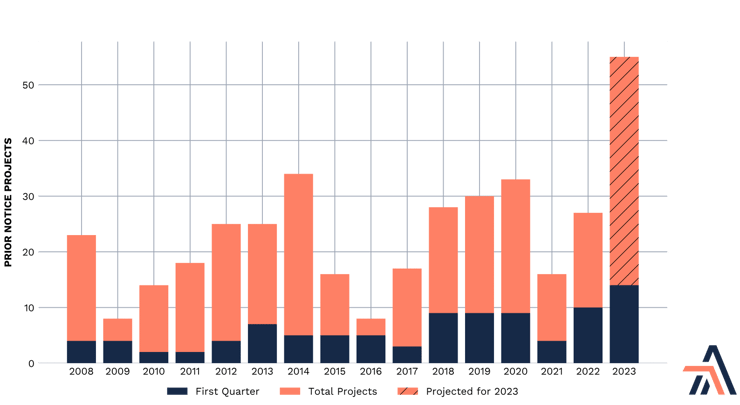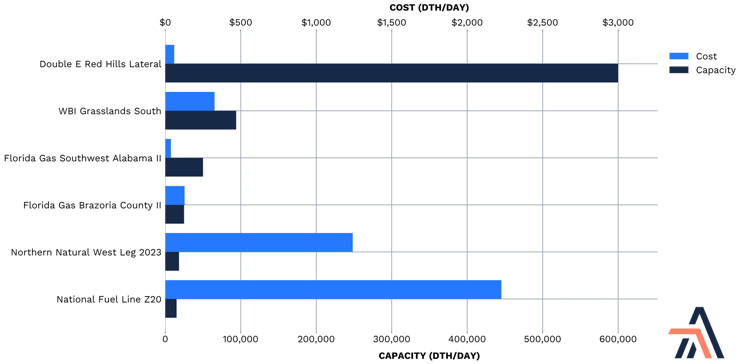Could 2023 Be the Year of the Prior Notice Projects?
Originally published for customers January 6, 2023.
What’s the issue?
When most pipelines, except for Rover Pipeline, are granted a certificate of convenience and necessity to operate, they also receive a “blanket” certificate that allows them to do routine construction without filing for a new certificate under Section 7(c) of the Natural Gas Act.
Why does it matter?
This blanket certificate allows for two types of projects; automatic approval projects can be constructed without any notice to FERC except after the project is placed into service in an annual report that each pipeline files, while slightly larger and more complex projects, referred to as “prior notice” projects, require the pipeline to notify FERC of the intent to construct them. If no one protests the project within sixty days after FERC issues a notice of the application, or if any such protest is resolved within 90 days after the notice is issued, then the project can proceed without further approval by FERC.
What’s our view?
During Chairman Glick’s tenure even these very simple projects, if they were protested, became subject to his obstructionist policy of requiring the preparation of a full Environmental Impact Statement. So far this fiscal year, the number of these prior notice projects is on track to greatly exceed the number filed in any one year over, at least, the last decade. If one of the recently filed projects is protested, this may be an early indicator of whether acting Chairman Phillips will continue the obstructionist policies of Chairman Glick or return FERC to its practices under the Obama administration.
When most pipelines, except for Rover Pipeline, are granted a certificate of convenience and necessity to operate, they also receive a “blanket” certificate that allows them to do routine construction without filing for a new certificate under Section 7(c) of the Natural Gas Act. This blanket certificate allows for two types of projects; automatic approval projects can be constructed without any notice to FERC except after the project is placed into service in an annual report that each pipeline files, while slightly larger and more complex projects, referred to as “prior notice” projects, require the pipeline to notify FERC of the intent to construct them. If no one protests the project within sixty days after FERC issues a notice of the application, or if any such protest is resolved within 90 days after the notice is issued, then the project can proceed without further approval by FERC.
During Chairman Glick’s tenure even these very simple projects, if they were protested, became subject to his obstructionist policy of requiring the preparation of a full Environmental Impact Statement (EIS). So far this fiscal year, the number of these prior notice projects is on track to greatly exceed the number filed in any one year over, at least, the last decade. If one of the recently filed projects is protested, this may be an early indicator of whether acting Chairman Phillips will continue the obstructionist policies of Chairman Glick or return FERC to its practices under the Obama administration.
Prior Notice Applications Are Exceeding Historical Norms
The blanket certificate granted to most pipelines, other than Rover Pipeline, allows them to construct various facilities without the need to file a formal request under section 7(c) of the Natural Gas Act. The facilities that can be built include those that will lead to an increase in the overall capacity of a pipeline. In fact, one of the projects filed in this fiscal year by Double E Pipeline indicates that the proposed project will enable Double E to increase the supply into its mainline by over 600,000 dth/day. The blanket certificate includes two categories of projects, automatic approval and prior notice. Each category has its own dollar cost limit that is usually set for the calendar year in the first quarter of that year. Currently the 2022 limit, which was fixed on March 15, 2022, is $13.1 million for automatic approval projects and $37.1 million for prior notice projects. Because these limits are indexed for inflation, the amounts for 2023 are expected to increase substantially.
FERC’s fiscal year runs from October 1 to September 30. So any certificate application filed since October 1, 2022 would have a docket number starting with CP23 and we are just over one quarter of the way through the year. Looking back at the number of prior notice applications filed in each of FERC’s previous fiscal years, the number of projects filed so far in 2023 is running far ahead of the usual number of such prior notice projects.

As seen above, based on the fourteen prior notice projects filed in the first quarter, 2023 is on track to have over 50 such prior notice projects filed, which would be about 50% more than any year since 2008 and about double those filed in 2022.
The fourteen projects filed so far this fiscal year are about evenly split between expansion projects and maintenance projects.

As seen above, this expansion capacity can come pretty cheaply, from a low of just $38 per dth/day of capacity to a high of over $2,000 per dth/day.
Process and Protests
When a prior notice application is filed at FERC, FERC will issue a notice of the application. In that notice FERC fixes a date that is sixty days later by which any protests need to be filed. If there are no protests filed, then the project is automatically approved. In such cases FERC staff will prepare an abbreviated Environmental Assessment for the project and the applicant can then immediately begin construction. If a protest is filed, the applicant has until 90 days after the FERC notice was issued to resolve the protest, and if it cannot do so, then the application will be treated like a full application under section 7(c) of the Natural Gas Act. Prior to Chairman Glick’s tenure this would essentially mean staff would complete an Environmental Assessment and then FERC would issue an order approving the project. However, as we discussed in FERC Chairman’s Actions Confirm that All Pipeline Expansions Require an EIS, Chairman Glick viewed all expansions, or at least those in excess of 5,000 dth/day, as requiring the preparation of a full EIS. Thus, during his tenure a non withdrawn protest could result in such a delay that the project would die. That is exactly what happened to the Adelphia Pipeline project we discussed in that article.
As seen above, there have been six projects filed this year that create additional capacity for the pipeline, including one that creates 600,000 dth/day of additional supply for Double E Pipeline. The protest period has expired for only one of those projects, Florida Gas Transmission’s 50,000 dth/day expansion. We will be watching the other five, which have protest periods that expire between now and the end of February, to see if any are protested. In particular, the Double E Pipeline project has a protest period that ends on February 17. If it receives a protest, it could be an early indicator of whether acting Chairman Phillips continues to follow Chairman Glick’s policies or returns to the ones used by the Democrats who were FERC chairs under President Obama.
As we noted in Senator Barrasso Questions Whether FERC Really Withdrew Policies In March, Chairman Glick appears to have applied various aspects of the policies that he adopted in February 2021 and then withdrew in March 2021. Many suspect it is those actions that ultimately led to Chairman Glick not being confirmed by the Senate for another term. So it will be interesting to see if acting Chairman Phillips is willing to risk his continuing service by silently following these failed policies.
If, however, he returns to the policies used during the Obama administration, there is hope for the pending prior notice projects, but such an action may also signal some relief for full Section 7(c) projects as well, because they may no longer be subjected to the longer review time required to prepare a full EIS.